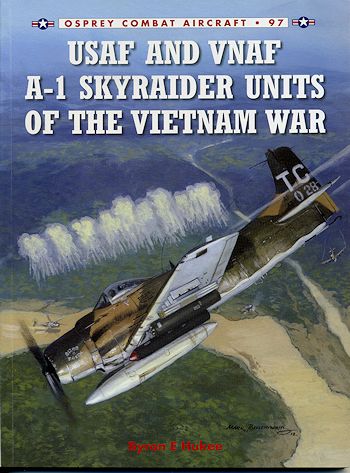 There is
one aircraft that was in the thick of combat from before the beginning until the
end of the war in Vietnam and that is the A-1 Skyraider. Initially provided to
the VNAF in 1960 as a replacement for their aged F8F Bearcats, many of these
aircraft were flown by American pilots, even though the aircraft were in VNAF
markings.
There is
one aircraft that was in the thick of combat from before the beginning until the
end of the war in Vietnam and that is the A-1 Skyraider. Initially provided to
the VNAF in 1960 as a replacement for their aged F8F Bearcats, many of these
aircraft were flown by American pilots, even though the aircraft were in VNAF
markings.
This experience came in handy when the US finally became
more open about the war in 1964 and USAF units were sent in to enhance what was
already being flown by the VNAF. These planes were all ex-USN Skyraiders as the
Navy was in the process of replacing these planes with more modern aircraft.
However, the Skyraider proved to be the perfect COIN aircraft. It had a useful
armament of four 20mm cannon and was able to carry a wide variety and number of
weapons on its hard points. It also was able to stay in the air a long time and
its relatively slow speed meant it was able to keep track of the situation on
the ground. This was particularly important during rescue missions of downed
pilots enabling many of these men to stay out of prison camps.
The author was a Skyraider pilot who served a tour of
duty in the last year of the US involvement during 1972/73 so has an affinity
for the aircraft that provides insights that ordinary authors might otherwise
overlook.
The book covers the full terms of the A-1 in both VNAF
and USAF operations from 1960 until the nation was brought under one rule in
1975. The book begins with some background on the A-1 and the types of ordnance
it normally carried. Since it was widely used in air rescue work, things like
marker rockets, smoke rounds and the such were normally carried along with more
lethal items like napalm, cluster bombs, rockets, and standard bombs.
It then goes into the initial VNAF and USAF units,
continuing in this vein through the war until all of the units that participated
in the fighting are covered. Each of these unit sections include more than the
usual day to day experiences and add in several of the more interesting or
harrowing missions carried out by the various units.
All during this the camouflage and markings of the
aircraft changed to some extent. This is visualized not only by an excellent
selection of period photographs, both in color and black & white, but also by
the usual superb full color profiles that are part of this particular series. As
part of the appendices, there is a listing of units as well as a timeline for
when these units were in operation during the war.
In all, it adds to the growing collection of superb
books in this series. I found it be a very good read and encourage anyone
interested in either the aircraft or this period of history to pick this one up.
It will be well worth it.
March 2013
For more on the complete line of Osprey books,
visit www.ospreypublishing.com
or contact them at Osprey Direct, PO Box 140, Wellingborough, Northants,
NN8 2FA, UK. In the US, it is
Osprey Direct at 44-02 23rd St, Suite 219, Long Island City, NY 11101., where you can
get a catalogue of available books.
If you would like your product reviewed fairly and
fairly quickly, please
contact the editor or see other details in the
Note to
Contributors.
 There is
one aircraft that was in the thick of combat from before the beginning until the
end of the war in Vietnam and that is the A-1 Skyraider. Initially provided to
the VNAF in 1960 as a replacement for their aged F8F Bearcats, many of these
aircraft were flown by American pilots, even though the aircraft were in VNAF
markings.
There is
one aircraft that was in the thick of combat from before the beginning until the
end of the war in Vietnam and that is the A-1 Skyraider. Initially provided to
the VNAF in 1960 as a replacement for their aged F8F Bearcats, many of these
aircraft were flown by American pilots, even though the aircraft were in VNAF
markings.